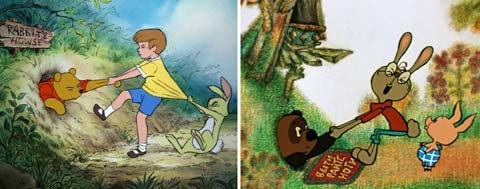Winnie the Pooh is a childhood favorite to many. For me, it brings back fond memories of storybooks and stuffed animals. As I reflected upon my love for a bear who eats way too much honey, I began to wonder if this childhood classic is the same in other places around the world. How universal is our childhood? As someone who seeks a future working with children of all different backgrounds, I was curious to see if there were cultural differences that created changes in how characters were portrayed.

Although I would not be watching Pooh and friends get themselves into trouble until the early 2000s, I stumbled upon a video that piqued my interest. It was a 1972 version of the playful Winnie and friends made in Russia. There were noticeable differences right away, starting with the appearance of Pooh, as well as the other characters. The United States version of Pooh is a golden bear with a big belly wearing a red shirt. However, the Russian version, seen on the left, is a circular, brown bear with a small smile and big claws. Nearly indistinguishable from the version many American’s have come to love.
There are some similarities between characters in both versions, such as Eeyore being a sad donkey down on his luck, but many of the Russian characters are different from their American counterparts. Although I love Winnie the Pooh, I believe many can agree his American transcription tends to portray a simple-minded, often lazy demeanor. In the Russian account, he is lively, smart, and tends to play the role of the leader. Owl is still intelligent and independent but is portrayed as a female. This may be out of respect, as Owl is wise and is made to teach children manners. If a child sees this, this may instill the idea of respecting adults, especially caretakers. During the time the film was made, the main caretaker in the home was typically the woman of the household. Piglet is portrayed as a young child full of excitement, much less timid than his Disney interpretation. I would say he plays the role of a kindergartener, which may make Russian children see him as easy to relate to. There is a portion where he cries for his “Mommy” and many characters cater to him like someone would to a child. Christopher Robin is not a part of the cast. The universe is strictly animals with no human interference. Pooh and friends are not stuffed animals, but rather real, living beings. Children can relate to these characters more because they are not simply the toys of a young boy, but “persons” with real feelings and issues.
The Adventures of Winnie the Pooh is fascinating to watch in another language, especially Russia. The Russian language does not utilize the American alphabet, instead, they use a mixture of symbols in writing. All Winnie the Pooh cartoons are in a storybook format, usually starting each episode with the title of the “chapter.” The Russian rendition had the same beginning, just with the text in Russian. Being exposed to text at a young age helps with the ability to read down the road.
Something I found interesting is the usage of music. Music is used in the Americanized version of the show as well, but Pooh’s songs tend to be more rapid-fire and direct in the Russian version. Russian people are known for their direct nature, so this may be a reflection of their communication style. In many scenes, music is playing that is distinguishably from Russian descent. There are many moments where Pooh and friends break out into a song while retrieving gifts for Eeyore. It seems that music is a key element in Russian culture and used for storytelling.
There is a line that translates to “But who cares? Nobody gives a damn,” which surprised me at first because this is atypical for an American children’s show. Langauge is a hot topic in American television censorship. However, in other countries, they may not see certain words as problematic as we do. The word “damn” in the American culture is seen as inappropriate to be used around children, but in Russia, it does not seem to be an offensive gesture. This shows how different cultures interpret things in different ways. Morals, ideals, traditions, etc. all vary from one country to the next, which impacts everything from political decisions to a children’s cartoon. We can learn from and celebrate our differences while also finding what makes us similar, even if we start with a chubby bear who just really loves honey.

Thank you for taking the time to read my blog!
Follow me on Twitter for more education related discussion:@EckhardtMalisa